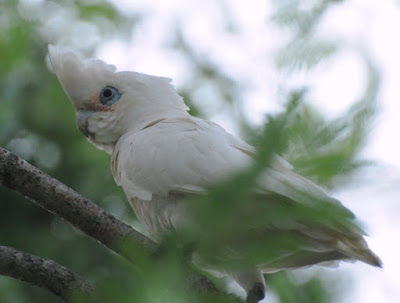Brisbane, like Sydney, has seen a considerable change in its urban birdlife since I first visited it on a boiling hot Christmas in 1972. A few small birds still hold their own, including this Willie Wagtail (Rhipidura leucophrys) near the ponds on the University of Quernsland campus (see previous entry), but by and large they have been supplanted by bigger, aggressive species.
One of the most surprising of the commoner birds on the University campus was this one, the Australian Brush Turkey (Alectura lathami). This is a bird guaranteed, despite its rather ungainly appearance, to set non-Australian birders' hearts a-flutter, and finding it stalking about on a campus lawn was unexpected to say the least. Residents like it far less.
The Brush Turkey's allure is its breeding behavior. It is not a turkey, but a megapode - a member of a largely Australasian family (there is one species on a few offshore islets in Malaysia) that bear the distinction of being the only birds in the world that do not incubate their eggs or care for their young. Instead (depending on the species) they bury their eggs in sandy soil or in a mound of rotting vegetation. The young hatch pretty much able to fly, dig themselves free and are on their own thereafter.
That doesn't mean that megapodes lack parental care - far from it. The mound-building species like the Brush Turkey tend their mounds with fanatical devotion, adding and removing vegetation to keep the interior at just the right temperature for their developing eggs. The mound scraped together by a pair of Brush Turkeys can be enormous: up to 6 metres across and a metre and a half high. That explains its unpopularity among suburban Brisbaneites: the birds are excellent at converting one's back garden into a miniature mountain of compost.
Cockatoos have proliferated in Brisbane. This is my favourite, a Galah (Eolophus roseicapillus), stalking purposefully across a tennis court.
Here a Sulphur-crested Cockatoo (Cacatua galerita) challenges me (and any rivals on the area) from a treetop.
Around the university ponds I found a gang of Little Corellas (Cacatua sanguinea), birds I used to associate with the Australian interior. Their numbers may be augmented by escapees from captivity.
They were completely uninterested in my presence, and were a delight to watch.
They were completely uninterested in my presence, and were a delight to watch.
Rainbow Lorikeets (Trichoglossus haematodus) were as abundant in the gardens of Brisbane as in Sydney.
Also common were Scaly-breasted Lorikeets (Trichoglossus chlorolepidotus), a species at the extreme end of its range further south in Sydney.
The abundant and aggressive Noisy Miner (Manorina melanocephala) dominates the urban birdscape in Brisbane as thoroughly as it does in Sydney. This appears to be a young bird.
There are plenty of crows in the city too, but these are not the same as the Sydney birds. Instead of Australian Ravens (Corvus coronoides), here there are Torresian Crows (Corvus orru), a common species across much of the northern half of Australia. I saw them in numbers - they roam about in flocks after the breeding season.
The members of the Cracticidae - bell-magpies, currawongs and butcherbirds - are not just aggressive towards small birds, but predatory (as the name "butcherbird" might imply). They are also birds with a great deal of personality and, for the magpies and butcherbirds at least, magnificent voices.
Australian Magpies (Gymnorhina tibicen) are really just large terrestrial butcherbirds with social lifestyles (including choral singing), and these days are often included in the butcherbird genus Cracticus.
Young magpies are considerably more mottled that their seniors.
Young magpies are considerably more mottled that their seniors.
Grey Butcherbirds (Cracticus torquatus) are widespread over much of Australia. They are aggressive hunters after smaller birds, and have a habit of wedging their kills into the forks of branches as storage for later on (rather like the habit of impaling birds on thorns practiced by shrikes (Laniidae), birds absent from Australia but probably the first to which the colloquial name "butcherbird" was applied). They are handsome birds and fine singers, but around Brisbane they are, I think, outdone in both departments by a close relative.
The Pied Butcherbird (Cracticus nigrogularis) is one of the finest songsters and best mimics in Australia.
This bird had gotten used to a daily handout from Sue's son Lawrence, and if this didn't appear on time it would wait impatiently at the kitchen window until the matter was remedied.

























No comments:
Post a Comment